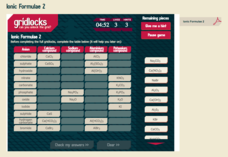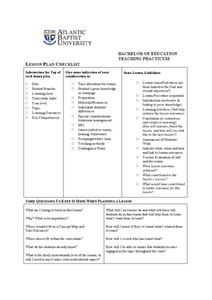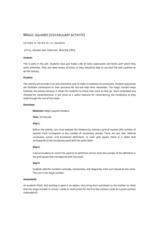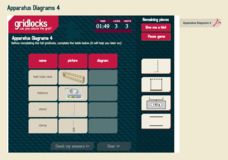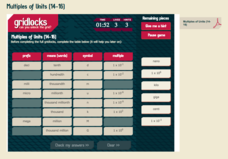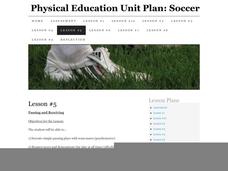Alabama Learning Exchange
Coordinate Geometry
Where do the coordinates lead? As children brainstorm ways to find the location of different buildings, they learn about coordinate points and how to use them to locate areas on a grid or map. They practice using ordered pairs by playing...
Curated OER
Graphing Equivalent Fractions
Students graph families of equivalent fractions and compare them by observing the slope of the line formed by each fraction family. They place fractions in ascending order by comparing the slopes of each line after several families of...
Royal Society of Chemistry
Elements 4
Don't miss the silver lining when you are looking for gold. A brain-bending interactive allows scholars to sharpen their puzzle skills while reviewing chemical elements, including silver and gold. First, pupils match 12 chemical elements...
Royal Society of Chemistry
Elements 3
Many pupils mix up the chemical symbols for calcium, carbon, and copper. These entertaining puzzles help scholars remember the names and symbols. First, they match the name and symbol of 12 elements. Then, through a series of three...
Royal Society of Chemistry
Periodic Table 1
Richard Feynman predicted the periodic table might go up to number 137—but never to 138. Scholars practice naming which elements belong in groups 1, 2, 7, and 0 on the periodic table in puzzles. They work through four puzzles reinforcing...
Royal Society of Chemistry
Naming Binary Compounds
Penguinone is an organic compound named because it resembles a penguin. Scholars match the name of binary compounds to the elements in each compound. Then, they solve three sets of puzzles reviewing the same content.
Royal Society of Chemistry
Elements 2
Did you hear about the chemist reading the book about helium? He couldn't put it down. Scholars match 12 chemical elements, including helium, to their symbols. Then they complete three Sudoku-style puzzles using these names and symbols...
Royal Society of Chemistry
Acids
She threw sodium chloride at me—that's a salt! Scholars match acids to their formulas as well as their salt compounds. Completing a series of three gridlock puzzles reinforces each of the matches in a logical manner.
Royal Society of Chemistry
Ionic Formulae 2
Scientists call ions with a negative charge anions. Scholars work through one matching puzzle and four logic puzzles reviewing the chemical formulas for anion ions. Each level increases in difficulty and solidifies the concept in pupils'...
Royal Society of Chemistry
Hydroxide Precipitates
When two liquids combine and a solid forms, the new substance is called a precipitate. Scholars test their knowledge of hydroxide precipitates and their properties. A series of four increasingly difficult puzzles challenge their logic...
Royal Society of Chemistry
Isomers of (E)-but-2-ene
One chemical formula—but how many different structures? Familiarize young chemists with the concept of isomers through simple, related games. Users identify each isomer base upon its name, structure, and type of isomerization in a set of...
Royal Society of Chemistry
Organic Formulae 2
Is your chemistry class frustrated by the multitude of representations of organic molecules? Add some challenging puzzles to an otherwise ho-hum organic lesson and let the fun begin! The second of a two-part activity focused on basic...
Royal Society of Chemistry
Shapes of Molecules—Distortion from the Pure Geometry
Ready to introduce the realities of molecular geometry to chemistry pupils? Use a logic-based interactive! Perfect as individual practice, the puzzles explore the bond angles and repulsions present in three common molecular shapes.
Royal Society of Chemistry
Some A-level Reagents
Learning names and formulas can be a daunting task for young chemists, so support their study with interactive puzzles! First, users match each formula with its correct name. Then, individuals use them to complete three logic games.
Royal Society of Chemistry
Flame Test Colours
Scientists identify elements by the color of flame they produce because each element is defined by exactly one line on the emission spectrum. By completing a series of puzzles, scholars reinforce their knowledge of the results of flame...
Curated OER
Rounding Decimals
Fourth graders engage in a instructional activity that is about the concept of rounding decimals. They review place value and focus it upon the practice of rounding. Students use 10 base decimal grids or models to help make connections...
Mathed Up!
Enlargements
Make enlargements with and without centers. Pupils work through seven problems dealing with dilations or enlargements. The first couple items are strict enlargements without centers, while the others have centers. Class members also...
Curated OER
Magic Squares Vocabulary: Catcher in the Rye
Magic squares make learning fun! Seriously! Learners use the given square to review vocabulary terms from J.D. Salinger's Catcher in the Rye. The 16 vocabulary terms are not divided by chapter, they represent the whole book. As learners...
Royal Society of Chemistry
Apparatus Diagrams 1
One of the biggest challenges for beginning scientists is figuring out the names of the equipment! Introduce your chemistry class to essential lab apparatuses using a series of related games. Pupils pair images of a test tube, funnel,...
Royal Society of Chemistry
Apparatus Diagrams 4
Lab tools are cool! But, which one is the right tool for the job? Young scientists participate in a series of puzzles focused around some common lab equipment. Each puzzle requires learners to associate the tool with its image and a...
Royal Society of Chemistry
Multiples of Units (14-16)
Most mnemonics for remembering the metric system only include seven words. Scholars need to know a few more to complete the included puzzles. They match the prefix to the meaning, symbol, and multiple in a series of four increasingly...
Code.org
Using Simple Commands
Turtles might be slow, but class will zoom by when your pupils build a program in which reptiles draw a grid. Using App Lab and JavaScript, class members build a program to find the most efficient way to draw an image of a...
PBS
Inspector Detector
How do spacecraft detect magnetic fields? The fourth installment of a five-part unit has learners develop a device with magnets that allows for the detection of magnetic fields. They use a map of an imaginary planet to try out their...
Curated OER
Physical Education Unit Plan: Soccer - Lesson 5
Here is part five of 10 soccer lessons, this one focusing on passing and receiving. Open this session with a video of professional soccer players executing a beautiful give-and-go passing situation which leads to a score! It doesn’t get...
Other popular searches
- Missing Number Grid
- Number Grid Patterns
- Number Grid 0 100
- Math Missing Number Grid
- Number Grid for Addition
- Number Grid 1000
- Number Grid 1 25
- Hundred Grid and Percents
- Addition Number Grids
- Number Grid Subtraction
- Letter Number Grid Maps
- Number Grid Worksheets







